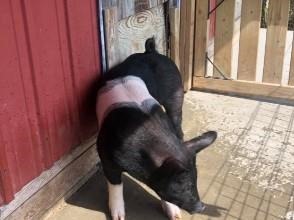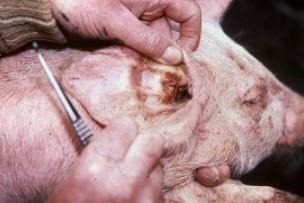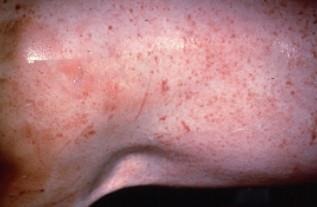By Elizabeth Ferry and David Thompson
Summer is finally here, with dry, hot weather kicking off the season. For people who show pigs in the Midwest, this is also the start of the exhibition season with shows and events nearly every weekend and county fair countdowns beginning. While this type of weather is normally expected at the end of summer, it always comes with its challenges. Among those challenges are keeping pigs cool and ensuring proper average daily gain. Another challenge in the Midwest this spring has been an uptick in occurrence of mange mite infections in show pigs.
What is mange?
Mange is an ectoparasite infection caused by a mite (related to spiders) that lives just under the skin of pigs and is spread from pig to pig by direct contact of the animals or contact with contaminated tools or equipment. Although mange mites typically perish within a few days under hot, dry conditions when no host animals are around to infect, they can also persist in the environment for up to three weeks under damp conditions. These microscopic ectoparasites cause pigs to itch and rub infected areas on any and all surfaces they find; eventually causing rough, scaly skin and often leading to the appearance of small red bumps covering the body of the pig. Mange infections usually start behind the ears, then spread across the body,
 Pigs with mange infections can been seen scratching on stationary objects, if this behavior is excessive and continues, you may want to consider treating with a product for external parasites.
Pigs with mange infections can been seen scratching on stationary objects, if this behavior is excessive and continues, you may want to consider treating with a product for external parasites.congregating in the folds around the neck, ears, and legs. An additional sign of mange infection is head shaking which occurs when ears become infected and can persist and lead to further physical damage. Initial signs of manage infections include excessive rubbing on stationary objects, particularly the head and rump areas, as the infection gets worse, you will see signs that the pigs are uncomfortable and both growth rate and feed efficiency can decline.
Products labeled to control manage infections
There are a number of products (called acaricides) available for purchase to prevent and treat mange mite infections:
- Avermectin products - The most effective products for treatment and control of mites are the avermectins. These products (common names Ivomec, Noromectin, Agri-mectin or Dectomax) are labeled for the treatment and control of mites as well as gastrointestinal roundworms, lungworms, grubs, and sucking lice in swine, cattle, and other livestock. For the most effective use of these products when given by injection, dosage should be delivered subcutaneously and follow label directions. A single dose (if injected) is usually effective. An oral formulation given in feed for seven consecutive days is
 Active infection in the ear of a pig. Photo courtesy of NADIS-UK (Mark White)also available. Under some conditions, including heavy infection of the ears (showing thick dark wax containing mites), or co-infection by hog lice, a second dose can be given two weeks after the first dose. The withdrawal period for these products varies between seven days (when given in-feed) to up to 24 days (some injectables), so it is important to review the product label carefully.
Active infection in the ear of a pig. Photo courtesy of NADIS-UK (Mark White)also available. Under some conditions, including heavy infection of the ears (showing thick dark wax containing mites), or co-infection by hog lice, a second dose can be given two weeks after the first dose. The withdrawal period for these products varies between seven days (when given in-feed) to up to 24 days (some injectables), so it is important to review the product label carefully. - Phosmet products – Another frequently used treatment option for mites, the phosmet-containing products (Prolate/Lintox-HD, Porect) which are poured or sprayed directly onto the animal. This acaricide, pour-on/spray product is used to control mange as well as horn flies, lice, and ticks on swine and cattle. Note that this product is not effective against parasitic worms. The withdrawal time for this product is one day after a single treatment; additional treatment, if needed, should occur 14 days following the first treatment. Phosmet can cause serious eye irritation, so it should be applied carefully following label directions and using proper safety equipment. It is a low-cost option that can be purchased in bulk and used as a spray to help decontaminate equipment and indoor pens.
- Pyrethrins - Pyrethrin-containing products (Atroban, SwineGuard) are available as pour-on or spray formulations. Permethrins kill adult-stage mites (and lice) quickly, but they do not bring the added benefit of efficacy against the internal parasites (worms) that typically infect pigs. Pyrethrins, when used to control mites in pigs, will typically require a second application 10-14 days after the initial treatment. These products have a 5-day withdrawal period, which should be adhered to prior to harvest. Pyrethrin sprays can also be used to help control residual mites that may be present on equipment and pen surfaces but should be used sparingly for this purpose because they are also highly toxic to bees and other beneficial insects.
- Amitraz - Amitraz-containing products (Taktic, Topline and PointGuard) are available as pour-on or spray formulations. These products are also effective against lice and ticks. For mite control in pigs, a second treatment 10-14 days following the initial application is typically required. These products typically have a 3-day withdrawal period. They are inexpensive and can be used as a spray to help control residual mites on equipment and pen surfaces. Most evidence suggests amitraz is less toxic to bees and other beneficial infects than pyrethrins.
Preventing mange infections
While proactively preventing mange infections in your herd is a worthy goal, through purchasing your animal from a reputable farmer and practicing sound biosecurity, there are instances where the introduction of mites and other parasites happens through purchased bedding products, contaminated equipment or contact with carrier animals (including people). A routine deworming program that also includes products labeled to control mange mites will help decrease the possibility that your show pig will become infected. Under most circumstances, the surest and simplest way to achieve prevention would be to treat your pig upon arrival on your farm with an avermectin product. This will eliminate mites on your pig, while also providing several weeks of protection against most parasitic worms. In most situations, your pig will require only one additional treatment with an avermectin one month before fair.
Alternative approaches to prevent infection might be more useful when other types of parasites pose a threat on your farm. For example, if tapeworms or whipworms are also a problem in your area, you could substitute Safe-Guard for Ivomec, and add one of the acaricides, pour-on/spray products listed above. Safe-Guard is not active against mites, but is extremely effective in controlling most internal parasites, including roundworms, whipworms, and tapeworms, and could be given on arrival and again 2-4 weeks prior to exhibition to ensure elimination of parasitic worm infections before the fair. Any one of the acaracides pour-on/spray products listed above could be given alongside Safe-Guard when it is administered 2-4 weeks before fair. Remember that a second application of the acaricide pour-on/spray product should be given 10-14 days following the first application to eliminate mites that hatch after the first application.
There is no withdrawal time associated with Safe-Guard and for that reason it is sometimes used in pigs right up to and even including fair week. However, if an active infection is present, use of Safe-Guard (or Ivomec) will lead to active shedding of worms in the feces of the animal. Typically, 95% of the shedding occurs within a week of treatment, but a few shed worms (especially Ascaris and tapes) can be seen in feces for up to two weeks following treatment. Giving Safe-Guard one month out, along with an acaricide at one month and again two weeks before fair, should eliminate mites, lice and all important varieties of worms in time for fair week while minimizing the risk of having embarrassingly large white worms sharing the floor of your pig’s pen at the fair.
 Hypersensitive reaction to mange mites in a growing pig - Photo courtesy of NADIS-UK (Mark White)
Hypersensitive reaction to mange mites in a growing pig - Photo courtesy of NADIS-UK (Mark White)Treating active mange infections
Although protecting your animals from mange infections before they occur is what all exhibitors should strive for, it is also understood that infections sometimes happen anyway. Infection could occur any time during your experience with the pig during its grow-out/finishing period. Early identification and proper treatment of parasite infections is key to maintaining the health of your animals. If you identify and confirm mange in your show pigs, aggressive action should be taken to eliminate these external parasites. In order to properly address an active mange infection in your animal, unless you use an avermectin, you will need multiple (at least two) treatments to completely eliminate mange from your animal. This is because treatments administered to pigs kill adult worms and larvae, but not eggs shed by the adult mites before treatment. Waiting two weeks to re-treat your pig gives any eggs remaining on the animal a chance to hatch and thereby become susceptible to the second round of drug treatment. If mange develops in your pig any time prior to fair, it could be treated using an avermectin, including an injectable given 1X or an in-feed product given for seven days. Alternatively, one of the acaricides pour-on/spray products listed above could be used with the two doses given anytime, including as late four weeks and two weeks before fair if infection occurs late in the fair season.
Managing exposure from the environment your animal lives in
While directly treating animals that have active mange infections is key to eliminating the external parasite from your herd, steps should also be taken to properly treat the facilities that the animals are housed in. Mange mites can live in areas without host animals (pigs) for up to five days, and longer if damp conditions exist. If you are treating an active infection, removing the animal from its pen, disposing of all used bedding products, and completely cleaning and disinfecting the area should be done. Disinfecting the area, gating and equipment with a bleach and water solution and allowing for time to completely dry will help eliminate mange mites that may be in the environment. For severe or persistent infections, the housing area and equipment that comes in contact with pigs can be treated (usually sprayed) with one of the low-cost insecticides (e.g., phosmet, permethrin or amitraz), which are labeled for farm use. These products can be applied by spraying the housing area, gating and equipment; label directions should be followed closely.
For animals housed outdoors, a routine and complete parasite control program should be followed to avoid serious infestations. As noted above, mites can survive off the pig for only a week or two. For animals penned outdoors, it is helpful to rotate penning areas when possible to help reduce exposure to mite and worm eggs and larvae that are shed into the environment. Also, as noted above, waiting two weeks following initial treatment using an acaricide to re-treat your pig gives any eggs left on the animal a chance to hatch and thereby become susceptible to the second round of drug treatment. This is especially important if a compound other than an avermectin is used.
All deworming products can be sourced over the counter from animal supply stores or online warehouses. When utilizing these products care should be taken to read and follow the label directions, adhering to both user and food safety recommendations. Questions regarding product selection and proper use can best be answered by a veterinarian familiar with your operation. Your vet will know what practices are working best on other farms in your area.
Summary
- Practicing standard farm biosecurity measures, especially purchasing your pig from a reputable farmer, isolating your new pig for at least two weeks from animals already on-farm, and thoroughly cleaning/disinfecting pens and equipment before placing pigs will help prevent mite infections. This includes keeping your animal separate when returning from a show from the animals that remained at home.
- Avermectin-containing products and several acaricides/insecticides that can be administered topically provide excellent control of mites.
- Avermectin products persist in pig tissues long enough to control most mite infections following a single dose. However, mite eggs are not killed by other acaricides approved for use in pigs because drug levels in the pig’s skin decline rapidly; eggs remaining on pigs following initial treatment can hatch and re-infect the pig. The effectiveness of those treatments is improved when a second dose of the product is administered 10-14 days following the first dose.
- Read and follow product labels carefully, especially for proper dose, method of administration, and withdrawal time recommendations.
- Consult with your veterinarian regarding mite (and other parasite) control strategies.
Source : msu.edu